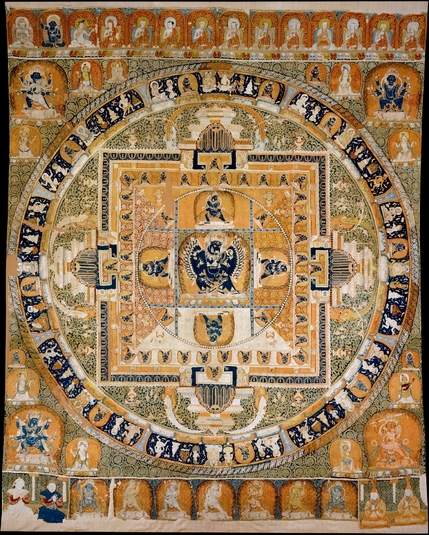
Item: Mandala of Vajrabhairava (Buddhist Deity) - Solitary (Ekavira)
| Origin Location | China |
|---|---|
| Date Range | 1300 - 1399 |
| Lineages | Sakya and Buddhist |
| Size | 245.50x209cm (96.65x82.28in) |
| Material | Ground: Textile Image, Embroidery |
| Collection | The Metropolitan Museum of Art |
Classification: Deity
Appearance: Animal-Feature
Gender: Male
Vajrabhairava, dark blue in colour, has nine faces, thirty-four hands and sixteen legs. The main face is that of a buffalo, with a red face above and the slightly angry yellow face of Manjushri placed on top. Flames shoot from the tips of the horns. The three right faces are yellow, blue and red and the three left are black, white and smoky. Each face has three large round eyes, bared fangs and frightful expressions; brown hair flows upward like flames. The first pair of hands hold a curved knife and skullcup to the heart. The remaining hands hold a multitude of weapons with the 2nd and last set holding in addition the fresh outstretched hide of an elephant. He is adorned with bracelets, necklaces and a girdle all formed of interlaced bone ornaments, a necklace of snakes and a long necklace of fifty heads. The right legs are bent pressing down on a man, animals and various gods. The left legs are extended straight and press upon eight birds and various gods; standing above a sun disc and multi-coloured lotus completely surrounded by the orange flames of pristine awareness. To each side of the lotus throne skullcups are filled with various offerings.
As a tutelary deity Vajrabhairava, also known as Yamantaka, belongs to the Bhairava and Yamari class of tantras and specifically arises from the Vajra Bhairava Root Tantra (Tibetan: jig je tsa gyu). All of those belong to the method (father) classification of Anuttaryoga Tantra. The practice of Bhairava is common to the three Sarma Schools: Sakya, Kagyu and Gelugpa. Among the Sakya it is counted as one of the four main tantric deities. There are numerous forms and styles of practice from the very complex with numerous deities to the very concise with a single Heruka form. The main lineages to enter Tibet were those of Jowo Atisha, Rwa Lotsawa, Mal Lotsawa and the like.
At the bottom left side are Emperor Tugh Temur, the 12th Great Khan of the Mongol Empire (1304-1332) and Prince Qoshila, the 13th Great Khan of the Mongol Empire (1300-1329). The female donors on the right side are Budashiri Qatun, consort to Tugh Temur, and Babusha Qatun, consort to Qoshila.
Exhibition: Mandalas, Mapping the Buddhist Art of Tibet (Mandalas)
Textile: Mandalas
Textile: Woven Artwork Main Page
Collection of The Metropolitan Museum of Art: Main Page
Painting Style: Yuan Period Art, Araniko School
Collection of The Metropolitan Museum of Art (Textiles)
Buddhist Deity: Vajrabhairava (Textile Masterworks)
Mandala: Sakya Masterworks
Region: China, Mandala Masterworks
Buddhist Deity: Vajrabhairava Main Page
Textile: Main Page
Buddhist Deity: Vajrabhairava Forty-nine Deity Configuration
Buddhist Deity: Vajrabhairava (Early Works, Painting & Textile)
Buddhist Deity: Vajrabhairava (Mandala Masterworks)
Buddhist Deity: Vajrabhairava (Textiles)
